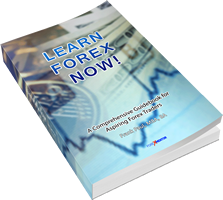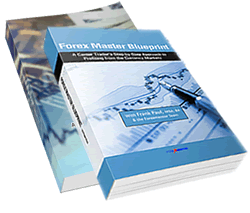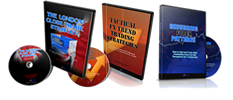"LEARN FOREX NOW!"
A Comprehensive Guidebook for Aspiring Forex Traders
Dear Aspiring Forex Trader,
You’ve heard just enough commentary “through the grapevine” to wonder whether Forex trading represents a possibly viable opportunity for making a part-time, or possibly even full-time income stream for yourself. And yet you’ve also done enough searching through pages and pages of sometimes skimpy, sometimes confusing, and sometimes flat-out misleading information available for free on the Internet to know that you need a more comprehensive introductory overview to help you understand what it’s all about – before diving headlong into the art and science of applying any particular trading methodology using a live trading account.
If, as either a newcomer to Forex trading or an aspiring trader with just one or two years of experience under your belt, you’ve ever found yourself wanting for a comprehensive, practical and most of all – completely realistic – overview of what the Forex industry is all about and what it takes to become a competent practitioner within it, then we just might have exactly the learning resource that answers most (if not all) of your most pressing questions: Our new guidebook (available in both hard copy and online versions) called LEARN FOREX NOW!
Objectives of This Book
First of all, let’s be clear up-front what this book is NOT: It is not a technical specification of any particular trading system or method; it is not an enumeration of all the steps to take in executing and managing a trade from start to finish; in short, it is not a how-to training manual of any kind that will specifically make you a trader, if that’s what you’re looking for.
What Learn Forex Now! does instead, is provide you a “one-stop-shopping” information-packed resource that explains what the Forex industry is, how it works, and what it will take for you to succeed in this profession. That latter question is the one that virtually no other book, online course, DVD or weekend seminar tries to honestly address, because the reality of this industry is that there are plenty of people who want to get you excited and sell you something, but there are few who explain the realities of trading, what it takes to become a trader, and what factors you need to assess to determine whether you are cut out for this business or not (and let’s face it, no profession is universally well-suited for any and all who might have a curiosity about it).
As George Pitcher’s Foreword to the document states so succinctly:
Learn Forex Now! is an excellent primer, particularly for those who are new to the market wanting a deeper understanding of what it is all about. One thing I especially noticed about the book the first time I read it is the amount of coverage devoted to analyzing one’s own trading personality to determine if Forex trading is truly right for oneself…In particular, Chapter 4 (entitled “Is Forex Trading Right For Me?”) should be required reading for all Forex newcomers, because it helps you deeply understand what it is you are trying to accomplish as a Forex trader, and to know whether this is an endeavor that fits with your personal situation.
So our primary objective in writing this book is to give you the “straight goods” about Forex trading, not just from the perspective of an industry overview, or the specification of all the tools, resources and knowledge you need to master to become a profitable trader; but also from the personal and psychological aspects of becoming a trader. By reading and studying the contents of this book carefully, you will substantially cut down on the length of your personal learning curve and get up-to-speed much more quickly than if you simply try to learn from a variety of different introductory sources.
» Click here to see full Table of Contents » Free Sneak Preview
Here’s What You Will Learn…
Learn Forex Now! is divided into two multi-chapter sections. Part I comprises Chapters 1 through 7 inclusive; Part II comprises Chapters 8 through 21. At the end of the text, you will find a handy Index and Glossary of Terms.
How you decide to tackle the contents of this book will depend in no small part on your prior level of trading experience. If that’s somewhere between little and none, then we strongly advise you start at Chapter 1 and work your way sequentially through all the remaining chapters, taking your time to really digest the contents of each before moving on to the next. This is the best way to build your personal knowledge base from the ground floor up.
If you are an already experienced trader, certain backgrounder elements (e.g. definition of the term ‘pip’ in chapter 2) may be of less interest. In that case, use our Table of Contents to navigate to chapters and sections containing more specialized topics of interest.
The 21 chapters in this book include the following:
PART I: FOREX ESSENTIAL QUESTIONS
- Chapter 1 – What Is Forex? The Forex industry is big. Really, really, really big. Most people don’t realize it, but Foreign Exchange is by a long shot the single largest business on earth. Nothing else comes even close. In Chapter 1, we give you a good basic overview of what the industry looks like (not to mention a more precise quantification than just “really, really, really big”).
- Chapter 2 – How Is Forex Traded? Don’t even think about ‘pulling the trigger’ (even if it’s just in a demo account) until you know the ins and outs of how Forex is transacted. In this chapter, we cover important concepts relating to the price quote, how Forex profit and loss are determined, the different categories of currency pairs, Position Sizing and Leverage, and much more. Studying Chapter 2 carefully should give you a good basic background in the mechanics of trade execution.
- Chapter 3 – What Do I Need to Trade Forex? In our review of the literature on Forex trading, we’ve found that almost nobody ever talks about this subject. And yet, wouldn’t it be helpful to know what the specific array of tools and resources are that you need to get up and running? From the basic specs on a suitable trading workstation, to what to look for in a charting platform (and a whole lot more), we’ll tell you straight up what you need.
- Chapter 4 – Is Forex Trading Right for You? Before you decide to embark upon a career (or even just a hobby) as a Forex trader, you need to determine if it’s likely to be a good fit for you. It might be, it might not. There’s no occupation in the world that can satisfy 100% of the population, and that’s true of Forex trading as well. In this chapter, we’ll give you a realistic, completely un-romanticized sense of what kind of person makes a good trader. Is that you?
- Chapter 5 – What Are the Different Styles of Forex Trading? You may already have heard terms like Scalping, Day Trading, Swing Trading or Position Trading, but not have a clear sense of what distinguishes one of these trading styles from another. Here, we’ll explain the differences and help you figure out which style might be best suited for you.
- Chapter 6 – What Can I Expect to Achieve from Forex Trading? How much money you can make trading Forex (and in the interest of full disclosure, lose, if you’re not careful) is dependent on a set of about a half-dozen key variables reflecting your trading situation and resources. In chapter 6, we’ll fully explain what those variables are, and suggest a checklist you can go through for the purpose of deriving expectations that are both realistic and prudent.
- Chapter 7 – What Are The Common Pitfalls of Trading, and How Do I Avoid Them? More people fail at Forex trading than needs to be the case simply because they don’t take the time to fully understand the pitfalls that can torpedo a trading account. Knowing what those pitfalls are, and better yet understanding how to avoid them, can give you a leg up on your trading competition and stead you for longer term success. That’s what Chapter 7 is all about.
PART II: TOOLS OF THE TRADE – AND HOW THEY’RE USED
- Chapter 8 – Introduction to Chart Analysis. There’s no way to avoid it: whether you plan to trade more on fundamentals than technicals or vice versa (or somewhere in between), you simply have to know how to read a chart before you can execute a trade. And regardless what particular trading style or method you end up making your own, knowing a little something about Top-Down Analysis, not to mention how to identify the tradable trend, is the crucial first step to becoming a proficient trader.
- Chapter 9 – Understanding Support & Resistance. Of all the topics in Technical Analysis that you need to know, the first and most important is the concept of Support/Resistance. Because even if you’re on the right side of the trend, these price levels can get in your way and scuttle your trade if you’re not careful. Conversely, market reactions to Support/Resistance can provide useful clues to getting in on a trade. In Chapter 9, we enumerate all the main varieties of Support/Resistance and explain how to look for them on your chart.
- Chapter 10 – The Wave Concept of Price Action: Progress and Regress. There’s only a few truisms we work with in this book – one of them being the proposition that price action unfolds in waves, simple patterns of progress and regress (‘two steps forward, one step back’) which in turn help us confirm the tradable trend. Chapter 10 shows how you can master this concept in a practical, hands-on way.
- Chapter 11 – Swing Point Patterns: The Turning Points in Price Action. Swing Points are simple price bar patterns which, when appearing in proximity to Support/Resistance levels (and a few other things), can provide reliable indications of a turn. Once you have the basic template committed to memory, you’ll be amazed at how much easier it becomes to navigate around market tops and bottoms…of any magnitude.
- Chapter 12 – Swing Point Progressions and Market Flow. Swing Points virtually always start and end the wave structures of price action we cover off in Chapter 10. And as we’re able to cobble together these wave patterns using Swing Points for the outline, we’re left with something called ‘Market Flow’ (also known simply as ‘trend’), an analytical element that is indispensable to your trading success.
- Chapter 13 – Using Chart Indicators, Part 1: Moving Averages. Everybody who’s a trader has at least looked at moving averages at one point in their trading career. In Chapter 13 we’ll introduce you to the different types and configurations, and give you a realistic assessment of both the strengths and weaknesses of this popular category of technical indicator.
- Chapter 14 – Using Chart Indicators, Part 2: Oscillators. As the name implies, an oscillator is a special type of chart indicator that plots a line cycling up and down between two polarities, often label ‘Overbought’ and ‘Oversold’ (for better or worse). In this chapter, we’ll introduce you to some of the most popular types, and debunk some of the potentially dangerous myths about how to use them.
- Chapter 15 – Using Chart Indicators, Part 3: Other Types. You never want to clutter your chart with so many indicators that you lose the proverbial forest for the trees. However, in addition to Moving Averages and Oscillators, there are several other indicators which can come in handy for many different uses – as long as they’re used sparingly. The most popular varieties are explained here.
- Chapter 16 – Putting It Together: The Necessary ‘Confluence of Events’. Finding technical signals for a trade is like playing the famous board game Clue. You need to whittle down just enough of the improbabilities to arrive at a successful conclusion. This means we work with not just a Swing Point pattern, not just a Support/Resistance level, not just an indicator reading, but all of those happening at once in close proximity on your chart(s) for a trade.
- Chapter 17 – Introduction to Fundamental Analysis. No trading topic engenders more controversy or debate among traders than Fundamental Analysis. Some feel you can’t trade without knowledge of economic metrics and the latest policy statement by Central Bank governors. Others feel you can’t trade with it, because – simply put – the markets are not ‘rational’ in a way that fundamental analysis implies. As Chapter 17 concludes, the truth lies somewhere in between.
- Chapter 18 – Risk Management Plain and Simple. It’s been stated in the trading literature – and quite rightly so – that the best traders are not primarily technicians, they’re risk managers. This is an important distinction because it shifts the focus away from being right all the time, a difficult thing to do in trading. Here, we’ll show how to structure your trades in a way that keeps risk to a prudent minimum, which in turn lets you see another trading day even after the occasional string of stop-triggered trades.
- Chapter 19 – Trade Management Plain and Simple. Trade management is not the same thing as risk management, although both concepts are interrelated. The task of trade management is to figure out where you’re going to get into the trade, where you’re going to place your Initial Protective Stop, when you’re going to remove risk from the trade, and where you’re going to take your exit.
- Chapter 20 – Developing A Trading Plan. Just remember one thing: Trading is a business, it’s not a video game. And like any business, we need to have a plan that guides our day-to-day actions. This section covers off the elements you need to consider, and set up for yourself some simple tools to track progress against that plan.
- Chapter 21 – Ten Practical Tips: Things To Do And Things Not To Do. There are probably hundreds of tips that would be worth considering, but in this section – the last of the book – we cover off what we believe are the Top 10 in terms of importance and relevance. Make these tips the cornerstone of your trading attitude and mindset, and you’ll be better off in the long run.
» Click here to see full Table of Contents » Free Sneak Preview
Who Will Benefit From This Book?
If you can relate your personal trading situation with regards to any of the following descriptions, then Learn Forex Now! is likely to be well-suited to your learning needs:
- People who are new to the Forex market but have trading or investing experience in other markets and but wish to know what sets Forex apart.
- Those completely new to the field of trading in general who are looking for a practical, well- presented introductory reference guide.
- Newcomers to Forex who are curious but perhaps not sure if it’s the right opportunity for them and want to know more before making the commitment to proceed with “demo” and “live” account trading.
- Traders frustrated by other introductory courses that failed to address all-important aspects of personal development such as trade readiness and what you need to succeed in this exciting market.
Learn Forex Now! is truly a fantastic resource that's an absolute must-have for all aspiring Forex traders. If you are familiar with author Frank Paul's other products, you already know that he delivers the best education value to our members.
Frank Paul
Senior Mentor
ORDER LEARN FOREX NOW! INTRODUCTORY OFFER

|
Onlinerequires internet connection |
Hardcopy |
|---|---|---|
| < | ||
| Full Book 226 pages |
✔ included | ✔ included |
| Online Version access immediately |
✔ included | ✔ included |
| Hardcopy | ✔ included | |
| Cost |
select "no shipping" |
plus shipping |
Get the "Learn Forex Now!" & "Forex Master Blueprint" Bundle and Save!

|
Onlinerequires internet connection |
Hardcopy |
|---|---|---|
| Full Book Both Books |
✔ included | ✔ included |
| Online Version access immediately |
✔ included | ✔ included |
| Hardcopy | ✔ included | |
| Cost |
select "no shipping" |
plus shipping |
For your convenience we accept:

Please contact us for other payment options such as wire transfers
To Order By Phone or Get Further Assistance:
North America Clients: Please call Toll Free: 1-800-516-0234
International Clients: Please call: +1-604-953-0234

TABLE OF CONTENTS
- FOREWORD
- INTRODUCTION
- OBJECTIVES OF THIS BOOK
- NO PRIOR CREDENTIALS REQUIRED
- HOW IT’S ORGANIZED
- WHERE TO FROM HERE
- ICONS USED IN THIS BOOK
CHAPTER 1 – WHAT IS FOREX?
- PURPOSE OF THIS CHAPTER
- FOREX DEFINED
- WHY TRADE FOREX?
- SIZE AND SCOPE OF THE MARKET
- THE PLAYERS
- REGULATORY OVERSIGHT
- 24/5 CONTINUOUS OPERATION
- GLOBAL TRADING CENTERS AND MARKET SESSIONS
- MARKET DRIVERS: FUNDAMENTAL, TECHNICAL AND ‘IRRATIONAL’
- RECENT TRENDS IN THE BUSINESS
CHAPTER 2 – HOW IS FOREX TRADED?
- PURPOSE OF THIS CHAPTER
- UNDERSTANDING THE PRICE QUOTE
- HOW FOREX PROFIT AND LOSS ARE DETERMINED
- UNDERSTANDING CURRENCY PAIRS
- THE USDX AND ITS IMPORTANCE – EVEN IF YOU DON’T TRADE IT
- POSITION SIZING
- MARGIN AND LEVERAGE
- ORDER TYPES
- THE ROLE OF THE BROKER IN RETAIL FOREX
- OK, SO WHAT AM I ACTUALLY DOING WHEN I TRADE?
CHAPTER 3 – WHAT DO I NEED TO TRADE FOREX?
- A SUFFICIENT AMOUNT OF STUDY AND EXPERIENCE
- A DECENT COMPUTER WORKSTATION
- A TRADING ACCOUNT WITH A REPUTABLE BROKER
- A QUALITY CHARTING PLATFORM
- A RELIABLE TRADING METHODOLOGY
- A PERSONAL TRADING BUSINESS PLAN
- ACCESS TO NEWS AND ECONOMIC ANALYSIS
- SOMEONE YOU CAN TURN TO FOR HELP
CHAPTER 4 – IS FOREX TRADING RIGHT FOR YOU?
- THE PERSONAL ATTRIBUTES OF A SUCCESSFUL TRADER
- THE TIME AND OTHER DEMANDS OF TRADING
- HOW LONG IT TAKES TO BECOME A TRADER
- CAREER VS. HOBBY
- PSYCHOLOGICAL ASPECTS
CHAPTER 5 – WHAT ARE THE DIFFERENT STYLES OF FOREX TRADING?
- PURPOSE OF THIS CHAPTER
- THE KEY ELEMENTS THAT DEFINE A TRADING STYLE
- WHERE DO YOU STAND?
- POSITION TRADING
- SWING TRADING
- DAY TRADING
- SCALPING
- THE ADAPTIVE APPROACH
CHAPTER 6 – WHAT CAN I EXPECT TO ACHIEVE FROM FOREX TRADING?
- THE INTANGIBLES
- VARIABLE #1: LONG TERM AVERAGE NET PROFIT
- VARIABLE #2: TRADING FREQUENCY AND VOLUME
- VARIABLE #3: ACCOUNT SIZE
- VARIABLE #4: COMPOUNDING EFFECTS
- SAMPLE RETURNS – SMALL, MEDIUM, AND LARGE
CHAPTER 7 – WHAT ARE THE COMMON PITFALLS OF TRADING, AND HOW DO I AVOID THEM?
- IMPATIENCE
- INCONSISTENT TRADING METHODOLOGY
- LACK OF A TRADING PLAN
- LACK OF TRADE READINESS
- OVER-LEVERAGED POSITIONS
- OVERTRADING
- POOR RISK MANAGEMENT
- POOR TRADE MANAGEMENT
- UNCERTAIN TRADING BIAS
- UNREALISTIC EXPECTATIONS
CHAPTER 8 – INTRODUCTION TO CHART ANALYSIS
- HOW PRICE INFORMATION IS ORGANIZED ON A CHART
- WHAT PRICE BARS TELL US: PROGRESS AND REGRESS
CHAPTER 9 – SWING POINT PATTERNS: THE TURNING POINTS IN PRICE ACTION
- SWING POINTS DEFINED
- HOW TO VALIDATE SWING POINTS
- DETECTING SWING POINTS WITH AN INDICATOR
CHAPTER 10: SWING POINT PROGRESSIONS AND MARKET FLOW
- WHERE DOES A TREND BEGIN?
- FROM A REVERSAL WAVE STRUCTURE INTO A SUSTAINED TREND
- THE TRADER’S MANTRA: BUY THE DIPS, SELL THE RALLIES
CHAPTER 11 – UNDERSTANDING SUPPORT & RESISTANCE
- WHAT IS SUPPORT?
- WHAT IS RESISTANCE?
- WHEN DOES SUPPORT OR RESISTANCE MATTER?
- FORMS OF SUPPORT/RESISTANCE
- SUPPORT/RESISTANCE ON DIFFERENT TIMEFRAMES
CHAPTER 12 – THE WAVE CONCEPT OF PRICE ACTION: PROGRESS AND REGRESS
- PRICE MOVES IN WAVES
- WAVES ARE EITHER IMPULSIVE OR CORRECTIVE
- CHARACTERISTICS OF IMPULSE WAVES
- CHARACTERISTICS OF CORRECTIVE WAVES
- USING FIBONACCI WITH WAVE STRUCTURES
- FRACTALS REVISITED
CHAPTER 13 – USING CHART INDICATORS, PART 1: MOVING AVERAGES
- WHAT IS A MOVING AVERAGE?
- WHAT MOVING AVERAGES CAN DO FOR YOU
- MULTIPLE MOVING AVERAGE PLOTS: PAIRS AND RIBBONS
- THE PROS AND CONS OF MOVING AVERAGES
- MACD: A DIFFERENTIAL OF TWO MOVING AVERAGES
- MACD DIVERGENCE AND HOW TO USE IT
CHAPTER 14 – USING CHART INDICATORS, PART 2: OSCILLATORS
- OSCILLATORS DEFINED
- STOCHASTICS
- RELATIVE STRENGTH INDEX (RSI)
- WILLIAMS %R
- THE PROPER FUNCTIONS OF AN OSCILLATOR
- THE IMPROPER FUNCTIONS OF AN OSCILLATOR
- HOW TO DETERMINE WHICH OSCILLATOR TO WORK WITH
CHAPTER 15 – USING CHART INDICATORS, PART 3: OTHER TYPES
- AVERAGE DAILY RANGE/AVERAGE TRUE RANGE
- BOLLINGER BANDS
- PARABOLIC SAR
- FORCE INDEX
- CONSTRUCTING YOUR OWN INDICATORS
CHAPTER 16 – PUTTING IT TOGETHER: THE NECESSARY ‘CONFLUENCE OF EVENTS’
- SINGLE TIMEFRAME CONFLUENCE
- MULTIPLE TIMEFRAME CONFLUENCE: THE TRIPLE SCREEN
CHAPTER 17 – INTRODUCTION TO FUNDAMENTAL ANALYSIS
- WHAT IS FUNDAMENTAL ANALYSIS?
- WHAT INFORMATION DO WE USE?
- USING OTHER ONLINE SOURCES
- NAVIGATING TRADES AROUND IMPORTANT NEWS EVENTS
CHAPTER 18 – RISK MANAGEMENT PLAIN AND SIMPLE
- WHY RISK MANAGEMENT IS CRUCIAL
- THE RISK PER TRADE CALCULUS
- PORTFOLIO RISK: AND HOW TO MANAGE IT
- HOW TO AVOID OVER-LEVERAGED POSITIONS
CHAPTER 19 – TRADE MANAGEMENT PLAIN AND SIMPLE
- PURPOSE OF THIS CHAPTER
- FIGURING OUT WHERE TO GET IN
- USING AUTOMATION TOOLS
- REMOVING RISK FROM THE TRADE
- PYRAMIDING THE POSITION
- FIGURING OUT WHERE TO GET OUT
- THE GOLDEN MANTRA: CUT LOSSES SHORT, LET PROFITS RUN
CHAPTER 20 – TEN PRACTICAL TIPS: THINGS TO DO AND THINGS NOT TO DO
- 1) ALWAYS EMPLOY PROPER TOP-DOWN ANALYSIS.
- 2) INSIST ON A CLEAR CONFLUENCE OF EVENTS.
- 3) IDENTIFY WHERE SUPPORT/RESISTANCE LIES.
- 4) REMEMBER TO ACTIVELY MANAGE YOUR TRADES.
- 5) PAY ATTENTION TO REWARD/RISK ATTRIBUTES.
- 6) CUT LOSSES SHORT, LET PROFITS RUN.
- 7) ONCE YOU HAVE YOUR TRADING METHOD, STICK WITH IT.
- 8) DO NOT TRADE A LIVE ACCOUNT BEFORE YOU’RE READY.
- 9) ADOPT A HUMBLE ATTITUDE TOWARDS THE MARKETS.
- 10) DON’T GIVE UP – YOU CAN DO THIS!
- INDEX
- GLOSSARY OF TERMS


